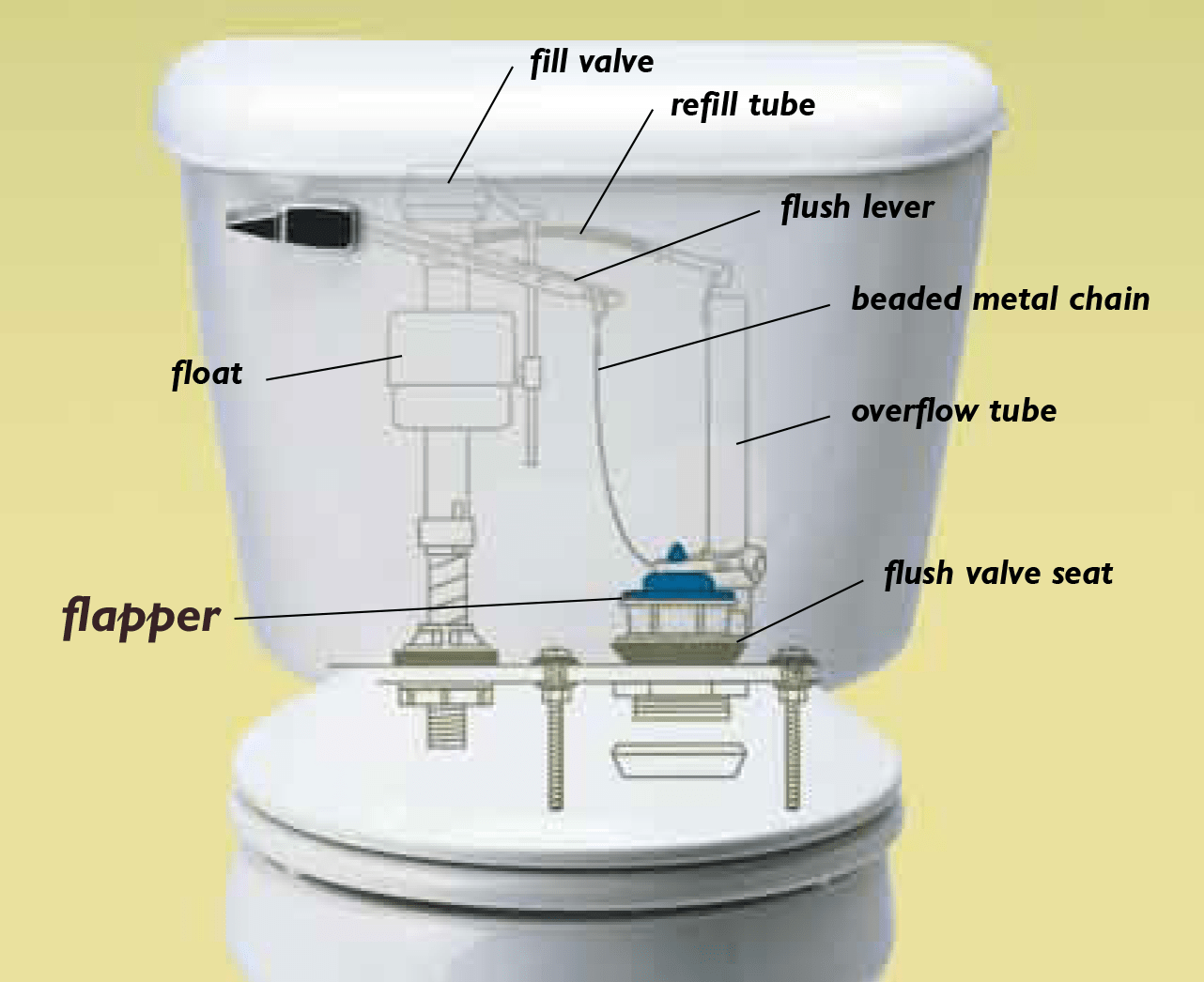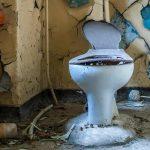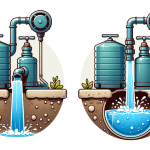At Dan’s Plumbing, we want to take the mystery out of your home plumbing issues. Today we are looking at a common problem that causes quite a bit of frustration: a running toilet tank. We’ll take you through the steps of identifying the issue, addressing common causes, quick fixes, and detailed diagnosis. Plus, we’ll offer an in-depth look at key toilet components and finding faults in the fill valve.
Contents
- Running Toilet Identification Guide
- Probing Toilet Mechanism Operations
- Acknowledging Common Running Causes
- Effective Strategies for Quick Fixes
- Detailed Diagnosis of Running Toilets
- Key Toilet Components Overview
- Finding Fault in Fill Valve
- How to Adjust Toilet Float
- Replacing the Faulty Tank Flapper
- Modifying Your Toilet’s Fill Valve
- Uninterrupted Toilet Running Issues
- Additional Tips for Consideration
- Conclusion
- Frequently Asked Questions (FAQ)
Running Toilet Identification Guide
The first step is identifying what a running toilet actually sounds like. Generally it’s that constant trickling or hissing noise coming from your loo when it’s not in use. According to the U.S. Environmental Protection Agency (EPA), toilets account for nearly 30 percent of an average home’s indoor water consumption, so this is a big deal, blokes!
A running toilet can waste up to 200 gallons of water per day. Depending on how severe the issue is, upwards of 500 gallons can be wasted. These statistics shared by the EPA and United States Geological Survey (USGS) should give you an idea just how crucial it is to address this issue.
Paying attention to your water bill can also help identify if there are any leaks as leaky toilets significantly increase water consumption. A study from the American Water Works Association found that as many as 35% of residential toilets are leaking. Want some proof? Watch that yearly water bill skyrocket.
Probing Toilet Mechanism Operations
Fancy understanding what’s going inside that porcelain throne? Understanding the functioning mechanism within your loo will help identify leaks better. Inside your tank can be thought of as two separate sections: The Flush Valve system and The Fill Valve System.
The Flush Valve System consists primarily of the overflow tube and flapper which regulate the start and end of each flush. The Fill Valve System, on the other hand, refills the tank after every flush and controls when to stop filling.
The key is identifying what kind of noise your toilet is making. If there’s a hissing sound, then it’s coming from water entering your toilet via the fill valve. A running water sound indicates that water is escaping through the overflow tube and that’s a problem rooted in your flush valve system.
Acknowledging Common Running Causes
So, you’ve mastered toilet sounds and now understand their mechanisms. Let’s delve into the common causes for a running loo. Top of the list is a faulty flapper or seal. They often deteriorate due to age or build-up of mineral deposits from hard water. Remembering that water is aggressive, blokes!
Another common cause could be an incorrectly sized flapper or an unlevel fill valve. Or, it could come down to a simple issue like a tangled lift chain. It’s all part of hydraulic engineering within our common household essential that makes it more complicated than they seem!
Last but not least, the water level could be set too high which would cause water to enter the overflow tube and drain away constantly. While adjusting this is easy, fixing things on your own can lead to unintended consequences, thanks to tricky home appliances.
Effective Strategies for Quick Fixes
Armed with the knowledge of common issues, it’s time we shed some light on quick fixes. These solutions range from replacing a worn-out flapper which is usually a universal fit across all commodes — just pop down to your local hardware store.
If you have an issue with lift chains, replace or adjust them so that they hang straight down from the lever with about half an inch of slack. Finally, adjusting the water level is as simple as moving the height adjustment clip up or down, preventing any further water wastage-related headaches.
According to the EPA’s WaterSense program, replacing old, inefficient toilets with newer models can net you a 20 to 60 percent reduction in water usage. A large number of homes in the U.S., around 70 percent according to Energy Policy Act (EPAct) regulations, have already made this switch. Can you imagine what a difference this could make here in Oz?
Detailed Diagnosis of Running Toilets
If none of these quick fixes suit your situation, it may be time for a detailed diagnosis. First step: turn off your water supply. This will prevent further water waste and make it easier to identify the problem. Start by inspecting the flapper for signs of wear or damage, before moving on to checking the fill valve for leaks.
If the problem lies with the overflow tube, check if it is secure and not damaged. Is it properly connected to the flush valve assembly? If all else fails and the toilet still runs, it could indicate a more serious issue with your plumbing system that requires professional help.
Key Toilet Components Overview

Understanding the different components that make up your toilet mechanism can be useful in identifying problems and applying solutions. There’s more to our bathroom buddy than meets the eye!
The flapper seals the drain hole at the bottom of the tank and controls the amount of water released during each flush. The filler float determines when your toilet tank has enough water while every household staple features overflow tubes for excess water to flow into when needed.
The lift chain connects the flapper to the handle lever – so when you pull that handle down every morning, you have this sturdy chain to thank for your smooth flush! Subsequently, the water supply line and valve controls all the water that enters your beloved loo.
Finding Fault in Fill Valve
The fill valve may not seem like the most glamorous part of your toilet, but it sure is important. When it’s faulty or set at an incorrect height, causes excess water to flow into the tank and through the overflow tube — definitely not ideal for water conservation!
Check if your fill valve is damaged or leaking. You might notice constant water flow even after the tank is full or that the water doesn’t stop at all. In these cases, consider replacing the whole unit with some help from Roto-Rooter, a well-established organization in the plumbing industry who are specialists in resolving such issues.
If it’s a minor issue, adjust the float arm to lower the water level. Remember to always turn off your water supply before starting any repair work on your toilet — no one wants a flooded bathroom!
How to Adjust Toilet Float
The toilet float is a key connector between the water supply and the flush valve. It’s responsible for regulating water levels in your tank, a critical factor that eliminates running toilets. If the float is set too high, water will continuously flow into the overflow tube causing the toilet to run indefinitely.
The process for adjusting the float depends on the type. Many toilets today use a cylindrical float that slides up and down along the fill valve. To adjust this type, squeeze the spring clip and move the float up or down. For older style toilets with a ball float, adjust the screw at the top of the fill valve.
According to The U.S. Environmental Protection Agency (EPA), toilets account for nearly 30 percent of an average home’s indoor water consumption. Thus, appropriately adjusting your toilet float could contribute significantly to reducing your home’s overall water usage.
Replacing the Faulty Tank Flapper

Tanks flappers create a seal within your toilet tank. When they deteriorate or become warped, which is common with age and use, they can’t form a proper seal and water leaks out — leading to a running toilet.
Here are steps on how to replace your flapper:
- Turn off the water supply line.
- Flush your toilet to drain remaining water in the tank.
- Unhook the old flapper from both sides of the overflow tube and remove it from its chain.
- Attach your new flapper to its chain, ensuring it’s long enough for proper function.
- Snap it back onto both sides of the overflow tube and turn on water supply.
The American Water Works Association points out that 20% to 35% of all residential toilets leak to some degree. So, replacing a faulty flapper could be a quick solution to a large percentage of running toilet issues.
Modifying Your Toilet’s Fill Valve
Your toilet’s fill valve controls the amount of water in the tank after each flush and also shuts off the water flow once the tank is filled. If it becomes faulty, it fails to stop water flow even after filling, causing a continuously running toilet.
The good news is that most fill valves can be easily replaced or repaired by homeowners. Just like replacing a flapper, start with the water supply turned off and drain the tank by flushing the toilet. When you put in the new valve, ensure it’s set to allow water level to reach approximately half an inch below the overflow pipe top.
The positive impact of fixing this issue cannot be underestimated – the EPA states that fixing easily corrected household water leaks can save homeowners roughly 10 percent on their water bills.
Uninterrupted Toilet Running Issues
Now, more complex problems may contribute to a constantly running toilet. These include worn out toilet bowl gaskets or broken parts that affect efficient functioning.
If you’ve tried adjusting your float, replaced your flapper and fill valve and your toilet continues to run, it might be time to call in professionals like us at Dan’s Plumbing. We have extensive experience troubleshooting and fixing all kinds of plumbing problems. We’re up-to-date with latest technologies like applying hydraulic engineering techniques for effective waste management.
Additional Tips for Consideration
Make sure to check your toilet for leaks regularly. An easy way is using food coloring. Put some in your toilet tank and if it appears in your toilet bowl without flushing, you have a leak which could create a running toilet over time.
Also, be aware of silent toilet leaks. The United States Geological Survey states that a silent leak in a toilet can waste from 30 to 500 gallons of water per day. Additionally, remember that changing out old toilets to more water efficient models can reduce usage further. According to The EPA’s WaterSense program, such replacements can improve efficiency by 20% to 60%.
Conclusion
Correcting running toilets helps conserve our precious water resources and also saves you money on water bills. Always try the basic fixes of adjusting your float or replacing faulty flappers and fill valves first. When those fail, don’t hesitate to call in an experienced professional like Dan’s Plumbing.
Frequently Asked Questions (FAQ)
What is the most common cause of a running toilet?
The most common cause of a running toilet is a faulty flapper or seal. The flapper creates a seal within the tank, and when it deteriorates or becomes warped, water leaks out, leading to a running toilet.
How do I stop my toilet from running?
You can start by replacing a faulty flapper, adjusting your water level, or fixing tangled lift chains. If these quick fixes don’t work, there might be more serious issues with your fill valve, overflow tube, or other components. Contact a professional plumber if you can’t identify the problem.
What are the parts of my toilet tank that could cause running?
Key components include the flapper, fill valve, overflow tube, float, and lift chain. Damage or improper adjustment to any of these parts can cause your toilet to run.
How much water is wasted by a running toilet?
A running toilet can waste between 30 to 500 gallons of water per day depending on the severity of the issue, which can significantly increase water bills and impact the environment.
How do I adjust the float in my toilet tank to fix a running toilet?
If your toilet uses a ball float, you can adjust the screw at the top of the fill valve. For a cylindrical float that slides along the fill valve, squeeze the spring clip and slide the float up or down to adjust.
How often should I check my toilet for leaks?
It’s good practice to check your toilet for leaks regularly, at least once every few months. A simple way is to use a food colouring test. If the colour appears in your toilet bowl without flushing, then you might have a leak.
What is the significance of fixing a running toilet?
Fixing a running toilet is essential for conserving water and reducing costs on water bills. It can save homeowners around 10 percent on their water bills according to the EPA.
When should I consider replacing my toilet?
Replacing your toilet may be appropriate if it’s old, inefficient or beyond repair. Newer, more efficient models can significantly reduce water usage and help conserve water.
- Can I Get a Plumber to Help Me Install An Under Sink Water Boiler in Our Office Kitchen? - September 14, 2024
- Can a Plumber Help Me Clear a Badly Clogged Toilet? - September 4, 2024
- Can a Plumber Help Me to Replace a Bathtub Drain Stopper? - August 29, 2024
Related posts:
 Can a Plumber Help Me If My Toilet Will Not Stop Running?
Can a Plumber Help Me If My Toilet Will Not Stop Running?
 Can a Plumber Help Me Install a Water-Saving Toilet in My Older Melbourne Bathroom?
Can a Plumber Help Me Install a Water-Saving Toilet in My Older Melbourne Bathroom?
 Is It Possible to Replace The Flush Buttons On a Toilet Suite?
Is It Possible to Replace The Flush Buttons On a Toilet Suite?
 How Do I Know If My Rainwater Tank Pump Is Working Properly?
How Do I Know If My Rainwater Tank Pump Is Working Properly?
 How Do I Know If I Have a Water Heater Leak? Can Plumbers Do a Test?
How Do I Know If I Have a Water Heater Leak? Can Plumbers Do a Test?
 How Do Plumbers Locate Hidden Water Leaks in Australian Homes?
How Do Plumbers Locate Hidden Water Leaks in Australian Homes?



